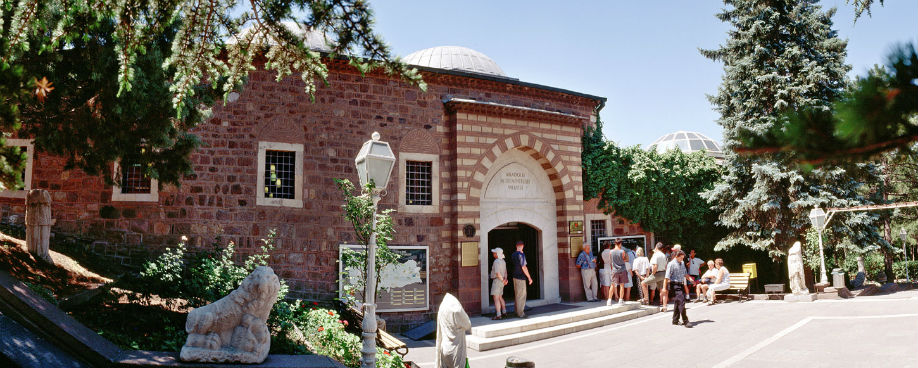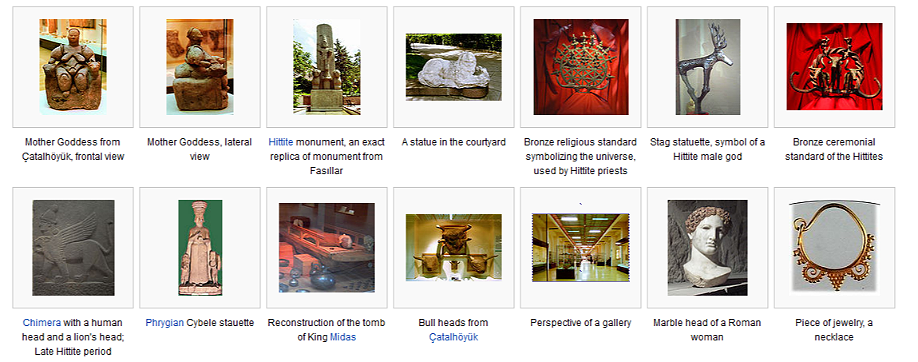The superb Museum of Anatolian Civilisations is the perfect introduction to the complex weave of Turkey’s ancient past, housing artefacts cherry-picked from just about every significant archaeological site in Anatolia.
The museum is housed in a beautifully restored 15th-century bedesten (covered market). The 10-domed central marketplace houses reliefs and statues, while the surrounding hall displays exhibits from the earlier Anatolian civilisations: Palaeolithic, Neolithic, Chalcolithic, Bronze Age, Assyrian, Hittite, Phrygian, Urartian and Lydian. The downstairs sections hold classical Greek and Roman artefacts and a display on Ankara’s history. Get there early to avoid the flood of tour groups and school parties.
The exhibits are chronologically arranged in a spiral: start at the Palaeolithic and Neolithic displays in the room to the right of the entrance, then continue in an anticlockwise direction, visiting the central room last.
Items from one of the most important Neolithic sites in the world Çatalhöyük, southeast of Konya – are displayed here. There’s a mock-up of the inside of a dwelling typical of those uncovered at the site, one of the most famous mother goddess sculptures unearthed from the excavations and wall paintings of hunting scenes.
Also on show are many finds from the Assyrian trading colony Kültepe, one of the world’s oldest and wealthiest bazaars. These include baked-clay tablets found at the site, which dates to the beginning of the 2nd millenium BC.
One of the striking Hittite figures of bulls and stags in the next room used to be the emblem of Ankara. The Hittites were known for their relief work, and some mighty slabs representing the best pieces found in the country, generally from around Hattuşa, are on display in the museum’s central room.
Most of the finds from the Phrygian capital Gordion, including incredible inlaid wooden furniture, are on display in the museum’s last rooms. The exhibits also include limestone blocks with still-indecipherable inscriptions resembling the Greek alphabet, and lion- and ram-head ritual vessels that show the high quality of Phrygian metalwork.
Urartian artifacts are also on display here. Spurred by rich metal deposits, the Urartians were Anatolia’s foremost metalworkers, as the knives, horse-bit, votive plates and shields on display demonstrate. There are also terracotta figures of gods in human form, some revealing their divine powers by growing scorpion tails, and neo-Hittite artefacts.
Downstairs, classical-period finds and regional history displays provide a local picture. Excavations have unearthed a Roman road near the Column of Julian, and Ankara has its own ‘missing link’, the 9.8-million-year-old Ankarapithecus (a 30kg, fruit-eating primate).




Nevertheless part of the Museum was closed, the areas that we visited were incredible, if you like history without massive areas, this Museum is the place in Ankara
Anatolian Civilizations Museum is located on the way of Ankara Castle. It is for tourists who want to see the history of Anatolia with visuals,
The place is currently under renovation and we were only able to see the main hall..they charged us full fee nonetheless :-(( What we saw though was good..the relics and antiques were great.
A deep dive into the history of Anatolian Civilization, very broad range of content.
worth a visit if you are in Ankara. But dont make the trip just for this as Ankara is not a nice place
This museum is great, Wonderful items on display and certainly well presented. Another must see place in Ankara.
The collection is just stunning. there are things here that take your breath away and leave you wondering at just what we have lost over time.
Anatolian Cicilisation Museum is one of the best in the world. It goes almost 10.000 BC. One can see all civilizations such as sumerians, hit its etc in this museum. Unfortunately they do not have enough space to exhibit all pieces. Only 0.1% on the exhibition
The museum's collection is fabulous and covers everything from what is possibly the world's first map and wall-art done at one of the world's first cities (Catal Huyuk) to the artifacts from a culture that rivaled Egypt but is sadly little-known outside of Turkey (the Hittites). Well worth a visit and a proper examination. The museum is located in the…
While small, this place had a great selection of artifacts from a number of different eras of Turkish history. For about 5TL, you can get a little iPod-like thing with headphones that will give you a virtual tour guide in about 20 different languages. That really made the visit informative. They have a nice outdoor cafe with Turkish coffee and…